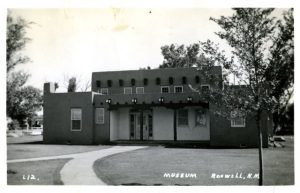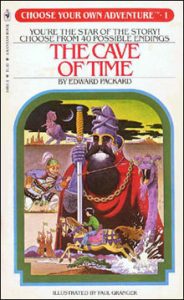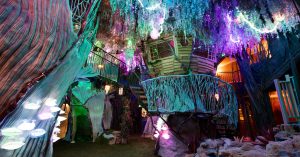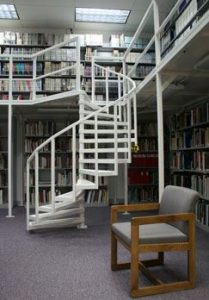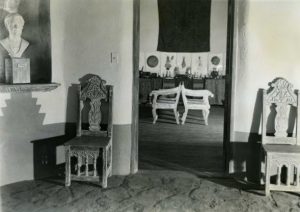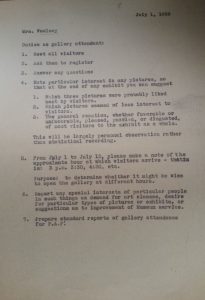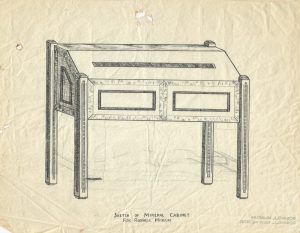As you know from my post about my DH semester project, I made a Scalar book about the Roswell Museum’s WPA archive. Scalar was still quite new to me at the time, so I hadn’t discovered all the cool things I could do with it yet. Today then, I’d like to take another look at that project and share some of its conceptual framework with you.
The advantage of Scalar is being able to build nonlinear narratives or repositories thanks to the use of links and paths. I wanted to apply that openness to the archive, allowing viewers to let their interests dictate their exploration of the materials. As I worked, I kept three different genres or experiences in mind to help me think about creating paths or links.
The first was the choose-your-own-adventure story. I admittedly didn’t read a lot of these as a kid, but I remember having to write one in middle school for an English assignment. It wasn’t a great story, something about a troubled teen running away and getting into shenanigans, but the experience of crafting multiple narratives within the same overarching plot stuck with me.
I also thought about immersive art or theatre experiences, more specifically The House of Eternal Return in Santa Fe. Designed by the art collective MeowWolf, this super trippy installation has become one of the most popular attractions in the City Different since it opened in 2016, Set inside an old bowling alley, viewers are presented with a Victorian house that acts as a portal to a multiverse. Your objective is to figure out what happened to the family that lived here, but the narrative is really just an excuse to explore a variety of rooms or environments. Since there’s no set path through the house or its various worlds, visitors decide where to go and how they’ll get there, whether it’s through a portal in the refrigerator, or bypassing the house altogether and walking through the backyard. Unlike choose-your-own-adventure stories, which put you on a specific narrative path depending on your choices, MeowWolf’s work is more opened-ended, presenting you with the material and letting you decide what you want to see.
The strongest influence on my Scalar work, however, was the archive itself, and my own experiences with exploring it. I did not go through these materials in a linear fashion. Initially, I tried doing that, but I quickly found that it was not the most efficient way to begin constructing the museum’s narratives, as the first five folders consisted of only time sheets. Instead, I jumped around between folders and boxes as I tried to figure out the museum’s early histories. I would spend months working on nothing but correspondence folders, for example, then focus on a folder filled with exhibition checklists or timesheets once I had gotten the context from the letters. I might spend weeks working on documents from 1938 only, or progress from 1937 to 1942 in a single day. Or I might focus on photographs and try to figure out which room I was looking at, or which exhibition was on view based on what I had read in the correspondence and checklists.
In short, my own exploration of the archive was open-ended, especially in the beginning when I wasn’t sure what I was even looking at. I wanted to give viewers the same opportunity to bounce around the materials and make their own discoveries.
Aside from open-endedness, the other main factor dictating my Scalar content was acknowledging other voices or perspectives, particularly staff contributions. The primary voices represented in the archive are directors and administrators since they completed most of the paperwork. I wanted to make sure that the custodians, gallery attendants, or carpenters, got their credit too.
We frequently discussed the idea of invisible labor and giving contributors their due credit in my DH class, but it also informed my curatorial practice. From my experience, fewer things build resentment faster than not having your work acknowledged, so I avoided that by giving credit where it was due. An exhibition is a collaborative effort, not a solo endeavor, so I always made a point of highlighting my teammate’s contributions in staff meetings, gallery talks, and lectures.
I applied that same philosophy to the archive by making the staff contributions more prominent. I gleaned names and job duties from correspondence, time sheets, memos, drawings, and other documents. From there, I created separate pages for each of the staff members I could identify and listed their job duties and contributions. I cited documents that mentioned them, and when available, uploaded documents that they had worked on, as is the case with the drawing above, attributed to a carpenter named Leonard Hunt. I took the references that were buried in the archive and made them more prominent, giving visitors an opportunity to learn not just about what was done at the museum, but who did it.
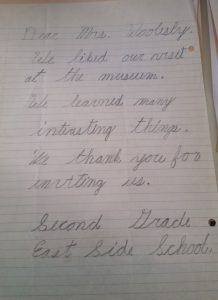 The other voice you rarely hear from is that of the visitors themselves since there aren’t a lot of written documents from them. Whenever I could, I uploaded documents from visitors, giving them a chance to express their thoughts on the museum.
The other voice you rarely hear from is that of the visitors themselves since there aren’t a lot of written documents from them. Whenever I could, I uploaded documents from visitors, giving them a chance to express their thoughts on the museum.
In the long run, this work is no substitute for a full digitization of the Roswell Museum’s archive. On its own, however, I think the Scalar book has its own merits as a document by not only providing a narrative for the museum’s history, but also by giving visitors a chance to explore the materials according to their interests while highlighting staff efforts. It may not house of all of the archival documents, but for what it is, I’m proud of it.
